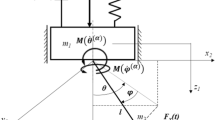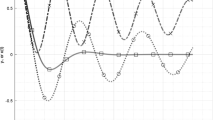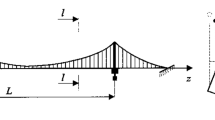Summary
Free damped vibrations of an oscillator, whose viscoelastic properties are described in terms of the fractional calculus Kelvin-Voight model, Maxwell model, and standard linear solid model are determined. The problem is solved by the Laplace transform method. When passing from image to pre-image one is led to find the roots of an algebraic equation with fractional exponents. The method for solving such equations is proposed which allows one to investigate the roots behaviour in a wide range of single-mass system parameters. A comparison between the results obtained on the basis of the three models has been carried out. It has been shown that for all models the characteristic equations do not possess real roots, but have one pair of complex conjugates, i.e. the test single-mass systems subjected to the impulse excitation do not pass into an aperiodic regime in none of magnitudes of the relaxation and creep times. Main characteristics of vibratory motions of the single-mass system as functions of the relaxation time or creep time, which are equivalent to the temperature dependencies, are constructed and analyzed for all three models.
Similar content being viewed by others
References
Suzuki, K.: A brief survey of research works about vibration damping. Trans. Jpn. Soc. Mech. Eng. C.59, 2908–2914, (1993) [in Japanese].
Suarez, L. E., Shokooh, A.: On the response of systems with damping materials modeled using fractional calculus. In: Applied mechanics in the Americas, Vol. 2 (Godoy, L. A., Idelsohn S. R., Laura, P. A., Mook, D. T. eds.), pp. 147–152. Santa Fe, Argentina: AAM and AMCA 1995.
Koh, C. G., Kelly, J. M.: Application of fractional derivatives to seismic response analysis of base-isolated models. Earthquake Eng., Struct. Dyn.19, 229–241 (1990).
Tsai, C. S.: Temperature effect of viscoelastic dampers during earthquake. J. Struct. Eng.120, 394–409 (1994).
Mace, M.: Damping of beam vibrations by means of a thin constrained viscoelastic layer: evaluation of a new theory. J. Sound Vib.172, 577–591 (1994).
Rabotnov, Yu. N.: Equilibrium of an elastic medium with aftereffect. Prikl. Matem. Mekh.12, 53–62 (1948) [in Russian].
Rabotnov, Yu. N.: Creep of structural elements. Moscow: Nauka 1966 [in Russian].
Annin, V. D.: Asymptotic expansion of an exponential function of fractional order. Prikl. Matem. Mekh.25, 769–798 (1961) [in Russian].
Rozovsky, M. I.: About one feature of the order of a special operator and its application to the dynamic problem solution. In: Creep and endurance limit (Rabotnov, Yu. N., Malinin, N. I., eds.), pp. 128–133. Novosibirsk: USSR Academy of Sciences 1963 [in Russian].
Meshkov, S. I., Pachevskaya, G. N., Shermergor, T. D.: To the description of internal friction in terms of fractional exponential kernels. Zh. Prikl. Mekh. Tekh. Fiziki3, 103–106 (1966) [in Russian].
Meshkov, S. I., Pachevskaya, G. N., Postnikov, V. S.: Material behaviour under large intensity of the dissipative processes. Fizika Khim. Obrab. Material.2, 135–137 (1967) [in Russian].
Bagley, R. L., Torvik, P. J.: Fractional calculus—a different approach to the analysis of viscoelastically damped structures. AIAA J.21, 741–748 (1983).
Bagley, R. L., Torvik, P. J.: A theoretical basis for the application of fractional calculus to viscoelasticity. J. Rheol.27, 201–210 (1983).
Koeller, R. C.: Applications of fractional calculus to the theory of viscoelasticity. J. Appl. Mech.51, 299–307 (1984).
Koeller, R. C.: Polynomial operators, Stieltjes convolution, and fractional calculus in hereditary mechanics. Acta Mech.58, 251–264 (1986).
Zelenev, V. M., Meshkov, S. I., Rossikhin, Yu. A.: Damped vibrations of hereditary-elastic systems with weakly singular kernels. J. Appl. Mech. Techn. Phys.11, 290–293 (1972).
Darinsky, B. M., Meshkov, S. I.: Singular kernels of heredity and relaxation and retardation spectra. Izv. AN SSSR. Mekh. Tverdogo Tela3, 134–140 (1969) [in Russian].
Meshkov, S. I.: Viscoelastic properties of metals. Moscow: Metallurgija 1974 [in Russian].
Cole, K. S., Cole, R. H.: Dispersion and absorption in dielectrics. J. Chem. Phys.9, 341–351 (1941).
Meshkov, S. I., Pachevskaya, G. N., Postnikov, V. S., Rossikhin, Yu. A.: Integral representation of ∋ λ and their application to problems in linear viscoelasticity. Int. J. Eng. Sci.9, 387–398 (1971).
Meshkov, S. I., Postnikov, V. S., Shermergor, T. D.: Temperature dependence of internal friction of a standard linear solid under intensive damping. Izv. AN SSSR. Mekh. Mashin.3, 90–95 (1964) [in Russian].
Meshkov, S. I., Shermergor, T. D.: About temperature dependence of damping coefficients. Izv. AN SSSR. Mekhanika5, 103–106 (1965) [in Russian].
Author information
Authors and Affiliations
Rights and permissions
About this article
Cite this article
Rossikhin, Y.A., Shitikova, M.V. Application of fractional derivatives to the analysis of damped vibrations of viscoelastic single mass systems. Acta Mechanica 120, 109–125 (1997). https://doi.org/10.1007/BF01174319
Received:
Revised:
Issue Date:
DOI: https://doi.org/10.1007/BF01174319




